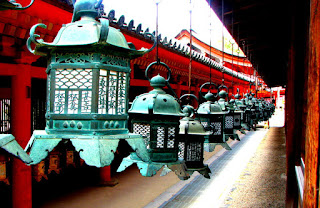There are so many, many photographs from our visit to the ancient city of Nara, a seat of Buddhism in Japan that I am having a lot of trouble deciding which to post. Forgive me if there are too many, and feel free to do a fast "flip" through them. Also, because I am curious, I did look up many of the statistics that you will find in this entry. You know how it is. Someone says, "Wow, it's huge!" and you want to know, "How huge is huge?"
First, the deer in Nara. They are sika deer and are sacred because they are considered to be messengers of the gods. A person causing harm to one of these deer faces heavy penalties. For that reason, the deer wander wherever they wish. Because they are fed by tourists (deer snacks are conveniently sold), they are constantly begging for food. Sometimes they don't wait to be fed. They just start chewing on whatever is around: your shoelaces, the edge of your jacket, the bag you're carrying, whatever. And then they wipe their mouth and/or noses on any part of you they wish.
This is the approach to the torii gate which if you look carefully has obviously not yet undergone any of the extensive restoration evident in other similar structures on our trip. It is even more clear in the second photo below. The Temple complex was finished in 752, but as with most wooden structures, it burned down and was rebuilt probably more than once. The structure below is still ancient and will be restored.
You may also notice D watching the deer in the lower right in hat, light jacket, and jeans .
This photo gives you a better look at the roof supports and shows the need for structural attention (painting, too!),
Just another "fascination" of mine. I love doors and doorways.
Compare this structure which has been lovingly restored with the gate above, and you see what that gate may look like after the necessary work is completed. This is the Great Buddha Hall which is 157 feet in height.
Below is the giant bronze statue (49 - 53 feet in height depending on the source) of Great Buddha Vairocana who represents "absolute reality and wisdom". If you look at the candles in front which are the same size as the ones in following photos, it will give you some idea of his size. He was cast in 752 although parts of the statue were damaged in earthquakes, the most recent repair was in 1692.
The figure below is Kokuzo Bosatsu. A "botsatsu" is an enlightened being.
Here one has the opportunity to make a donation and then take a candle. Lighting the candle brings good fortune for the person in whose name it is lit. Below you see four candles that D and I lit (two each). The top two are for our daughter and the bottom two are for our grandson.
Then there was this magnificent heavenly guardian, Kamokuten. If I had my choice, I'd pick him as he looks both capable and fierce!
The second heavenly guardian is Tamonten. I wasn't able to find out the significance of what he is holding, but I assume they would help him get the job done.
The second enlightened being is Nyoirin Kannon.
After enjoying the Temple and its deer, we left and went to a Shinto Shrine. A Shinto Shrine is the place for "happy" events, and we were lucky enough to see a bridal couple. They were happy enough to allow us to take their photograph. Weren't we lucky? Just look at the beautiful robes!
Here is our guide explaining the significance of this pathway lined by stone lanterns. They were often erected to honor a family member who had died. A lighted lantern was considered an offering to Buddha, and we were told there were 1,000+ on the grounds.
In such a busy place, I found this sight very peaceful and personal. Two people are bowing in reverence at this small, secluded shine on the grounds.
Here are two favorite views of the "avenue of lanterns" (my designation). Since I couldn't decide which one to post, I'm giving you both.
And here are two more views of lanterns - just different types but with the same meaning,
As I mentioned, the Japanese go to Shinto shrines to celebrate happy occasions, and we were once again privileged to come across one such occasion. We met this mother and her sleeping son and family as they were returning from a christening type of ceremony. Her mother proudly draped her in the "boy" kimono so all of us could take the proper photo. That little fellow didn't stir once despite our oohs and aahs of admiration. Who can resist a sleeping baby!
These two young women are attendants. I believe their function has changed from the original one, but I could not get an explanation of what they do.
And finally, just a serene photograph of a charming view.
By the time we left the Shinto Shrine, we were all rather hungry and were glad to be going to lunch. Here it is, a typical Japanese meal and very good!
After lunch we hurried off back to Kyoto to take the bullet train to Tokyo. As you can probably tell, our days were full!






















what beautiful photos!! The restored temple is amazing. The happy couple and baby sleeping in moms arms remind us that we are all alike, despite our minor differences. And lunch? Well, I have a feeling I would have come home with baggy clothing!
ReplyDelete